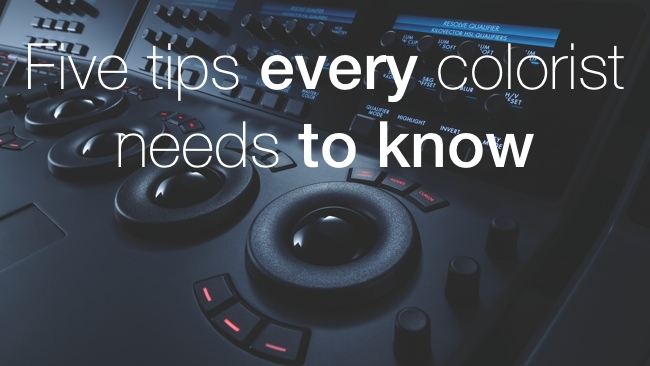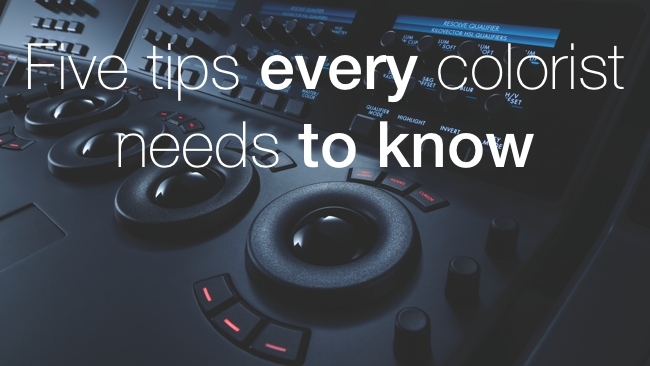

RedShark Replay: Grading is one of those skills that is incredibly difficult to master. So this seemed an opportune time to repeat the piece where Warren Eagles shares five top tips shedding light on the dark art of color grading and the life of a colorist.
Ours is a dynamic industry. From lens to screen and all points between, the rapid advance of technology inevitably creates both roses and thorns for professional ‘guardians of the image’. The benefits of shooting log or raw are clear but the downstream workflow can certainly cause headaches, and as digital cinema evolves, the necessity to develop the skillset of the colorist becomes more important than ever. I’ve known seasoned editors blanche at the thought of working with Resolve. But help is at hand. Warren’s road map outlines the qualities you’ll need to bring out the best in your images, enhance your story and, if your ambition is to become a colorist, give speed and direction to your career.
Some of Warren’s points are general sound advice covering a wide range of roles in the creative industries; mostly it’s good old common sense. Other points are more specific to students of grading. But, whoever you are, if you’re focusing your energy and time to address each one, all things being equal you’ll have an interesting and profitable relationship with the photon muses.
The tips are software agnostic. Warren on the other hand isn’t. He’s been using DaVinci since the days of the 888, long before Blackmagic Design acquired the company and has been instructing Resolve users ever since. He started his grading career in Soho in 1989 before moving to Australia in 1999. He runs his own shop in Brisbane, and splits his time equally between grading and training. Having just completed work on a feature and a TV Commercial, he set off on a whistle-stop world tour to deliver a series of Resolve classroom training sessions for the International Colorist Academy which he co-founded in 2009 with Kevin Shaw to provide training for colorists and post pros involved in DI workflow (DIT, editors, cinematographers, directors). Other ICA instructors include Dado Valentic, Simon Walker, Paul Lear and Von Thomas.
If you’re still not sure how a good colorist can improve your content, you’re not alone. In response to yet another client (in this instance a producer) asking the perennial question ‘What does a colorist actually do?’ Warren has posted a film to his Vimeo channel that explains everything. You can check it out here. At the time of writing this has received over 76,000 views. That’s a lot of confused producers!
Warren has a long list of credits for Film and TV and kindly agreed to share his vast industry knowledge and experience with RedShark readers. I ambushed him during the lunch break of the ICA Resolve 11 training session at Dolby Studios’ London HQ in Soho. Time was against us so I asked Warren for bullets. Here they are in no particular order — Warren’s Five Incredible Tips:
- Be creative, know what you like.
- Understand the new cameras and their codecs.
- Be a good business person.
- It’s all about the clients.
- Match the scene, and do it quickly!
So, in detail...
Be creative, know what you like
“An individual with an opinion stands out in people’s minds. As a colorist, we are working on a project because someone has brought it to us so that we can add something to it. They could do it themselves, maybe they’ve edited it or directed it too, but it’s good for them to take it to someone else for fresh input. So we need to offer something that will aid the story telling. Building looks is possibly the most creative aspect of a colorist’s skillset, but it must relate to the story.
“The story is always the most important thing; if we grade a commercial or a film we are always looking to add to that. For example can help the story by making it more sinister, a bit darker? Can we bring up that pack shot in a coffee commercial? Can we help to draw the viewer in and say ‘this is what I want you to look at’? So we need to be able to offer strong ideas and styles. They won’t all get accepted or liked but we need to be able to do that, and do it fast. A colorist has to be quick in today’s market.
“It’s really important to know what you like. As a starting point, let’s say ‘I like this director, I like this style’. Start collecting the things you like; build up a stock library of films, trailers, music videos and photos and create a store of mood boards that reflect your own artistic interests and personality, and then use them as reference material to inspire looks. Study the history of film and know what was shot on what.
“For instance I like the style of what Roger Deakins shoots. I love his movies. Skyfall was amazing, but I also like the Godfather DP Gordon Willis, LA Confidential DP Dante Spinotti, the list goes on. That’s what I like. When I create a look and present it to the director I need to be able to back that up with confidence and say ‘I like this, and this is why this look suits your product or film’. They might not like it, that’s fine, but you have a repertoire of looks that you can offer as starting point for the grade. You can cite a seminal film or scene where the director may have seen something similar and you then become an integral part of the creative process. You are building a relationship of trust and that’s how you’ll get the call for the next project.”
Understand the new cameras and their codecs
“Along with a strong creative streak, you also need to be technically proficient. Not necessarily with a Broadcast Engineering Masters, but you must have a solid knowledge of the different camera formats, in particular the pros and cons of working with this or that codec and the pipeline you are working in.
“Our initial responsibility is to match the scene. We’ll talk more about this shortly, but it isn’t uncommon these days to be working with four or five different formats on one timeline and that complicates our job. If you don’t understand the inherent characteristics of each file format (raw, log, bit depth, compression and resolution) you will not know how much you can push and pull the images before they break.
“For that you need to identify the weakest link in the chain and know for instance, if it’s less than 10-bit, that’s where your problems are likely to come from. If a client gives us baked footage to work on and the original r3d files are sitting on a drive somewhere, their ignorance isn’t your defence. We are the experts and we need to ask for the assets that allow us to give the client the best possible results.
“On larger productions the colorist is more often involved at the start. This is current best practice and the discussion between colorist, director and DP about the choice of cameras and codecs means that we can avoid images that fall apart in the grade. A good colorist will have a deep understanding of color science.”
Be a good business person
“You could be the world’s best colorist in your bedroom, but if no one knows you’re there you wont get any work. You’ve got to be proactive; Pay It Forward; update your show reel, share it and make it visible, be active in the forums offering advice and network constantly.
“You’ve got to be seen and that doesn’t necessarily suit some people. You really can’t afford to sit on your laurels. You have to be a good marketer and you have to be easily contactable. Even whilst you’re working on your current job you need to be thinking of the next project. That’s not impossible if you understand that every completed job with your name on it acts as your ambassador to potential clients.
“Thanks to YouTube, Vimeo and social media our calling card is out in the world, working hard to generate new business 24/7. But don’t just expect plum jobs to present themselves on a plate; create your own opportunities. You need a rate card and a set minimum of hours that you can send out to people. Some clients will want to negotiate and will haggle but if you don’t set your rate and a minimum hours contract there’s nowhere to start.
“Don’t set your rates too low thinking you’ll undercut everyone and get the business. People understand the principle of paying for quality so don’t be too eager to come in at a low price. It’s a race to the bottom and no one wins in the end. You can always lower your price to suit, but it never works the opposite way around.
“Once you’ve completed a job you need paying, and that’s down to you too. You have to be on the ball with your invoicing, keeping good accounts etc.”
It’s all about the clients
“More and more colorists are working freelance. As we move further into this freelance world we become more reliant on repeat business and it’s a harsh fact that you are only ever as good as your last job: Drop off the radar for any length of time and the phone will soon stop ringing.
“We have to be constantly offering things. You may even be working for free (we all do that in this industry) just to start a relationship with a new director. It doesn’t matter if it’s a low/no budget short or feature, if you take on a job you have to treat it as though it’s exactly the same as a top-paying client. You never know when these people will be back, hopefully with a budget.
“It’s a gamble of course, so choose wisely; they could get on a roll, start to work on larger projects and out of the blue you get the call. It happens. You are constantly building relationships with your clients, inspiring confidence and if you are talented and lucky you’ll get the call for the next job.”
Match the scene
“It’s relatively easy to create a look on one shot, but the hard thing is to be able to match to the next shot. I often say to students (with a wry smile) that you could sit a monkey down at a control surface and let him muck around with the controls and he might come up with something we quite like…He could do, but not in a million years will he match it to the rest of the film.
“That’s the key skill and you have to be able to do this quickly. It doesn’t happen over night, it takes years to become a proficient colorist. Consistency is what we are aiming for. It allows the audience to continue to willingly suspend their disbelief. Poorly matched shots shatter the illusion at the speed of light.
“Skin tones are your main focus. It is the Number 1, commented on more by clients than any other subject in the picture. Time of day color temperature shifts, when it is our main source of light, has a knock-on effect that ripples through everything it illuminates, especially skin tones.
“You must know the story. Even if it’s a commercial, watch it over before you attempt a grade. Ask for footage as early as possible so you can start to locate your hero shots. The more you know about the project the better the grade. You probably already know from your own experience that even when you’re away from the monitor you can be problem solving.
“My last piece of advice is don’t be tempted to sit in the studio for hours. Tired colorists don’t make good decisions. Take short breaks every couple of hours, come back with fresh eyes, and if the look isn’t working, bin it. A subtle and deft touch is what’s needed here.”
Warren Eagles can be found on Twitter at @warreneagles or you can visit https://www.warreneagles.com.au/, fxphd.com or icolorist.com.
Tags: Post & VFX



Comments